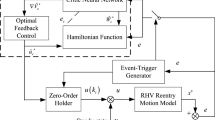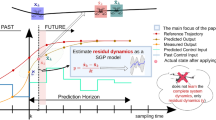Abstract
An optimal 3-dimension trajectory-tracking guidance method for Reusable Launch Vehicle (RLV) is proposed based on back-stepping Adaptive Dynamic Programming (ADP). The reference trajectory is generated based on the Gaussian pseudo-spectral method with sufficient saturation constraints on inputs. The reentry dynamics are normalized and modeled as position and velocity subsystems, based on which back-stepping approach is applied to derive the velocity virtual command which effectively reduces the position errors. A single-critic ADP structure is designed to achieve the optimal feedback control with an innovative weight iteration algorithm which reduces training computation, accelerates weights convergence and improves guidance accuracy. The proposed RLV guidance method is validated through the Monte Carlo simulations with initial errors, aerodynamic uncertainty and external disturbances. Comparable results with conventional guidance method based on Linear Quadratic Regulator (LQR) and weight iteration algorithm based on gradient decent demonstrate the advantages of the proposed guidance method.












Similar content being viewed by others
Data availability
The datasets generated during the current study are not publicly available due to the fund requirements but are available from the corresponding author on reasonable request.
References
Bae S, Shin HS, Savvaris A et al (2020) Multi-objective suborbit/orbit trajectory optimisation for spaceplanes. Acta Astronaut 170:431–442. https://doi.org/10.1016/j.actaastro.2020.01.003
Aprovitola A, Iuspa L, Pezzella G, Viviani A (2021) Phase-A design of a reusable re-entry vehicle. Acta Astronaut 187:141–155. https://doi.org/10.1016/j.actaastro.2021.06.034
Jiang CW, Zhou GF, Yang B et al (2018) Novel guidance model and its application for optimal re-entry guidance. Aeronaut J 122:1811–1825. https://doi.org/10.1017/aer.2018.94
Sushnigdha G, Joshi A (2018) Re-entry trajectory optimization using pigeon inspired optimization based control profiles. Adv Space Res 62:3170–3186. https://doi.org/10.1016/j.asr.2018.08.009
Mao Y, Zhang D, Wang L (2017) Reentry trajectory optimization for hypersonic vehicle based on improved Gauss pseudospectral method. Soft Comput 21:4583–4592. https://doi.org/10.1007/s00500-016-2201-3
Nejat A, Mirzabeygi P, Shariat-Panahi M, Mirzakhalili E (2012) Using improved particle swarm optimization algorithm. ASME Int Mech Eng Congr Expo Proc 7:577–585. https://doi.org/10.1115/IMECE2012-88833
Chai R, Tsourdos A, Savvaris A et al (2020) Real-time reentry trajectory planning of hypersonic vehicles: a two-step strategy incorporating fuzzy multiobjective transcription and deep neural network. IEEE Trans Ind Electron 67:6904–6915. https://doi.org/10.1109/TIE.2019.2939934
Hsu CF, Lin CM, Yeh RG (2013) Supervisory adaptive dynamic RBF-based neural-fuzzy control system design for unknown nonlinear systems. Appl Soft Comput J 13:1620–1626. https://doi.org/10.1016/j.asoc.2012.12.028
Sushnigdha G, Joshi A (2018) Evolutionary method based integrated guidance strategy for reentry vehicles. Eng Appl Artif Intell 69:168–177. https://doi.org/10.1016/j.engappai.2017.11.010
Wang X, Li Y, Zhang J (2021) A novel IGC scheme for RHV with the capabilities of online aerodynamic coefficient estimation and trajectory generation. Mathematics 9:1–19. https://doi.org/10.3390/math9020172
Zhang W, Chen W, Yu W (2018) Entry guidance for high-L/D hypersonic vehicle based on drag-vs-energy profile. ISA Trans 83:176–188. https://doi.org/10.1016/j.isatra.2018.08.012
Omar SR, Bevilacqua R (2019) Hardware and GNC solutions for controlled spacecraft re-entry using aerodynamic drag. Acta Astronaut 159:49–64. https://doi.org/10.1016/j.actaastro.2019.03.051
Li Z, Yang T, Feng Z (2019) Re-entry guidance method based on decoupling control variables and waypoint. Aeronaut J 123:523–535. https://doi.org/10.1017/aer.2019.4
Pan L, Peng S, Xie Y et al (2020) 3D guidance for hypersonic reentry gliders based on analytical prediction. Acta Astronaut 167:42–51. https://doi.org/10.1016/j.actaastro.2019.07.039
Sarkar R, Mukherjee J, Patil D, Kar IN (2021) Re-entry trajectory tracking of reusable launch vehicle using artificial delay based robust guidance law. Adv Space Res 67:557–570. https://doi.org/10.1016/j.asr.2020.10.006
Bu X, Qi Q, Jiang B (2021) A simplified finite-time fuzzy neural controller with prescribed performance applied to waverider aircraft. IEEE Trans Fuzzy Syst. https://doi.org/10.1109/TFUZZ.2021.3089031
Bu X, Jiang B, Lei H (2022) Non-fragile quantitative prescribed performance control of waverider vehicles with actuator saturation. IEEE Trans Aerosp Electron Syst. https://doi.org/10.1109/taes.2022.3153429
Bu X, Qi Q (2022) Fuzzy optimal tracking control of hypersonic flight vehicles via single-network adaptive critic design. IEEE Trans Fuzzy Syst 30:270–278. https://doi.org/10.1109/TFUZZ.2020.3036706
Wang R, Tang S, Zhang D (2019) Short-range reentry guidance with impact angle and impact velocity constraints for hypersonic gliding reentry vehicle. IEEE Access 7:47435–47450. https://doi.org/10.1109/ACCESS.2019.2909589
Li G, Chao T, Wang S, Yang M (2020) Integrated guidance and control for the fixed-trim vehicle against the maneuvering target. Int J Control Autom Syst 18:1518–1529. https://doi.org/10.1007/s12555-018-0824-0
Shao X, Wang H, Zhang H (2015) Enhanced trajectory linearization control based advanced guidance and control for hypersonic reentry vehicle with multiple disturbances. Aerosp Sci Technol 46:523–536. https://doi.org/10.1016/j.ast.2015.09.003
Bu X, Wu X, Huang J, Wei D (2016) Robust estimation-free prescribed performance back-stepping control of air-breathing hypersonic vehicles without affine models. Int J Control 89:2185–2200. https://doi.org/10.1080/00207179.2016.1151080
Schierman JD, Ward DG, Hull JR et al (2004) Integrated adaptive guidance and control for re-entry vehicles with flight-test results. J Guid Control Dyn 27:975–988. https://doi.org/10.2514/1.10344
Wang Y, Lei H, Ye J, Bu X (2018) Backstepping sliding mode control for radar seeker servo system considering guidance and control system. Sens Switz. https://doi.org/10.3390/s18092927
Schlanbusch SM, Zhou J, Schlanbusch R (2022) Adaptive attitude control of a rigid body with input and output quantization. IEEE Trans Ind Electron 69:8296–8305. https://doi.org/10.1109/TIE.2021.3105999
Chen ZY, Meng Y, Chen T (2022) NN model-based evolved control by DGM model for practical nonlinear systems. Expert Syst Appl 193:115873. https://doi.org/10.1016/j.eswa.2021.115873
Zhang S, Zhao B, Liu D, Zhang Y (2021) Observer-based event-triggered control for zero-sum games of input constrained multi-player nonlinear systems. Neural Netw 144:101–112. https://doi.org/10.1016/j.neunet.2021.08.012
Liu Y, Xing Z, Chen Z, Xu J (2021) Data-based robust optimal control of discrete-time systems with uncertainties via adaptive dynamic programming. Optim Control Appl Methods. https://doi.org/10.1002/oca.2775
Hu C, Zou Y, Li S (2021) Adaptive dynamic programming-based decentralized event-triggered control of large-scale nonlinear systems. Asian J Control. https://doi.org/10.1002/asjc.2662
De Keyser A, Vansompel H, Crevecoeur G (2021) Real-time energy-efficient actuation of induction motor drives using approximate dynamic programming. IEEE Trans Ind Electron 68:11837–11846. https://doi.org/10.1109/TIE.2020.3044791
Zhang K, Zhang H, Liang X, Wang Z (2019) Neurodynamic programming and tracking control scheme of constrained-input systems via a novel event-triggered PI algorithm. Appl Soft Comput J 83:105629. https://doi.org/10.1016/j.asoc.2019.105629
Mu C, Sun C, Wang D, Song A (2017) Adaptive tracking control for a class of continuous-time uncertain nonlinear systems using the approximate solution of HJB equation. Neurocomputing 260:432–442. https://doi.org/10.1016/j.neucom.2017.04.043
Xu D, Wang Q, Li Y (2020) Optimal guaranteed cost tracking of uncertain nonlinear systems using adaptive dynamic programming with concurrent learning. Int J Control Autom Syst 18:1116–1127. https://doi.org/10.1007/s12555-019-0165-7
Liu L, Wang Z, Zhang H (2018) Neural-network-based robust optimal tracking control for MIMO discrete-time systems with unknown uncertainty using adaptive critic design. IEEE Trans Neural Netw Learn Syst 29:1239–1251. https://doi.org/10.1109/TNNLS.2017.2660070
Wang D, Mu C (2018) Adaptive-critic-based robust trajectory tracking of uncertain dynamics and its application to a spring-mass-damper system. IEEE Trans Ind Electron 65:654–663. https://doi.org/10.1109/TIE.2017.2722424
Zhang K, Zhang H, Jiang H, Wang Y (2018) Near-optimal output tracking controller design for nonlinear systems using an event-driven ADP approach. Neurocomputing 309:168–178. https://doi.org/10.1016/j.neucom.2018.05.010
Zhang W, Yi W (2021) Composite adaptive dynamic programming for missile interception systems with multiple constraints and less sensor requirement. ISA Trans 117:40–53. https://doi.org/10.1016/j.isatra.2021.01.040
Cui L, Wang S, Zhang J et al (2021) Learning-based balance control of wheel-legged robots. IEEE Robot Autom Lett 6:7667–7674. https://doi.org/10.1109/LRA.2021.3100269
Wei Q, Liao Z, Shi G (2021) Generalized actor-critic learning optimal control in smart home energy management. IEEE Trans Ind Inform 17:6614–6623. https://doi.org/10.1109/TII.2020.3042631
Zang L, Lin D, Chen S et al (2019) An on-line guidance algorithm for high L/D hypersonic reentry vehicles. Aerosp Sci Technol 89:150–162. https://doi.org/10.1016/j.ast.2019.03.052
Liu F, Hager WW, Rao AV (2015) Adaptive mesh refinement method for optimal control using nonsmoothness detection and mesh size reduction. J Frankl Inst 352:4081–4106. https://doi.org/10.1016/j.jfranklin.2015.05.028
Bu X (2018) Air-breathing hypersonic vehicles funnel control using neural approximation of non-affine dynamics. IEEE/ASME Trans Mechatron 23:2099–2108. https://doi.org/10.1109/TMECH.2018.2869002
Vamvoudakis KG, Lewis FL (2010) Online actor-critic algorithm to solve the continuous-time infinite horizon optimal control problem. Automatica 46:878–888. https://doi.org/10.1016/j.automatica.2010.02.018
Zhang H, Cui L, Zhang X, Luo Y (2011) Data-driven robust approximate optimal tracking control for unknown general nonlinear systems using adaptive dynamic programming method. IEEE Trans Neural Netw 22:2226–2236. https://doi.org/10.1109/TNN.2011.2168538
Yang Y, Fan X, Xu C et al (2021) State consensus cooperative control for a class of nonlinear multi-agent systems with output constraints via ADP approach. Neurocomputing 458:284–296. https://doi.org/10.1016/j.neucom.2021.05.046
Cui L, Xie X, Wang X et al (2019) Event-triggered single-network ADP method for constrained optimal tracking control of continuous-time non-linear systems. Appl Math Comput 352:220–234. https://doi.org/10.1016/j.amc.2019.01.066
Sun H, Zhang S (2020) Skip re-entry trajectory detection and guidance for maneuvering vehicles. Sens Switz. https://doi.org/10.3390/s20102976
Acknowledgements
The research is funded by Aeronautical Science Fund (2019ZC051009).
Author information
Authors and Affiliations
Corresponding author
Ethics declarations
Conflict of interest
The authors declare that there is no conflict of interests regarding the publication of this article.
Additional information
Publisher's Note
Springer Nature remains neutral with regard to jurisdictional claims in published maps and institutional affiliations.
Rights and permissions
Springer Nature or its licensor (e.g. a society or other partner) holds exclusive rights to this article under a publishing agreement with the author(s) or other rightsholder(s); author self-archiving of the accepted manuscript version of this article is solely governed by the terms of such publishing agreement and applicable law.
About this article
Cite this article
Wang, X., Quan, Z. & Zhang, J. Optimal 3-dimension trajectory-tracking guidance for reusable launch vehicle based on back-stepping adaptive dynamic programming. Neural Comput & Applic 35, 5319–5334 (2023). https://doi.org/10.1007/s00521-022-07972-1
Received:
Accepted:
Published:
Issue Date:
DOI: https://doi.org/10.1007/s00521-022-07972-1




